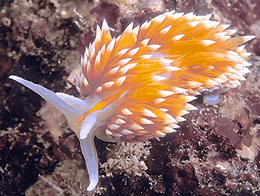Mollusks

Mollusks are a diverse group of invertebrate animals that belong to the phylum Mollusca, which includes creatures like snails, slugs, clams, oysters, octopuses, and squids.

Characteristics of
Mollusks
Mollusks display a diverse range of characteristics, but some common features define this phylum:
-
Soft body: Mollusks typically have a soft, unsegmented body that is often covered by a mantle, which secretes a protective shell in many species.
-
Shell: Many mollusks possess a hard outer shell made of calcium carbonate. However, not all mollusks have shells. For instance, squids and octopuses lack external shells.
-
Mantle: This is a specialized tissue responsible for secreting the shell in shell-bearing mollusks. It also plays a role in respiration and can sometimes produce coloration or aid in movement.
-
Radula: Most mollusks have a unique feeding organ called a radula, which is like a rough, toothed ribbon used for scraping or cutting food.
-
Bilateral symmetry: Mollusks generally exhibit bilateral symmetry, meaning their bodies can be divided into two equal halves along a central plane.
-
Foot: Many mollusks have a muscular foot used for locomotion. This foot can vary greatly in shape and function depending on the species.
-
Complete digestive system: They possess a mouth, digestive tract, and anus, allowing for the ingestion, digestion, and excretion of food.
-
Open circulatory system: Most mollusks have an open circulatory system where blood, pumped by the heart, flows through vessels and sinuses, bathing the organs directly.
-
Variety of habitats: Mollusks are incredibly adaptable and can be found in diverse environments, including oceans, freshwater habitats, and terrestrial ecosystems.
-
Sexual reproduction: Most mollusks have separate sexes, but some species can also be hermaphroditic (having both male and female reproductive organs).
Types of Mollusks
-
Gastropoda: This class includes snails and slugs. Gastropods are characterized by a single, coiled shell (in most species) and a muscular foot used for locomotion. They have a head with sensory tentacles and a radula used for feeding.

-
Bivalvia: Clams, oysters, mussels, and scallops belong to this class. Bivalves possess two hinged shells that enclose the body. They typically have a hatchet-shaped foot for burrowing into sediment or anchoring themselves.
-
Cephalopoda: Squids, octopuses, cuttlefish, and nautiluses are part of this class. Cephalopods are known for their complex nervous systems, well-developed eyes, and tentacles. Many have the ability to change color and texture for camouflage.
-
Polyplacophora: Also known as chitons, these mollusks have flattened bodies covered by eight shell plates. They inhabit rocky intertidal areas and use a large, muscular foot to cling to surfaces.
